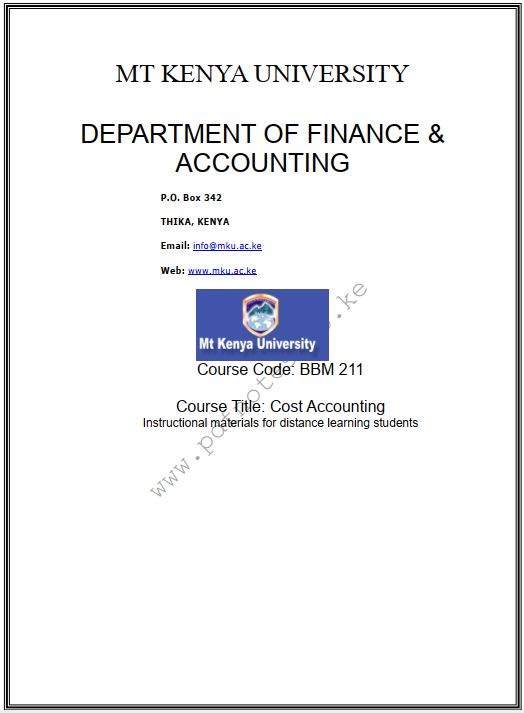
LESSON ONE: INTRODUCTION TO COST ACCOUNTING
1.1 Definition of and Scope of Cost Accounting
1.2 Purpose of Cost Accounting
1.3 Summary
1.3 Review Questions
1.4 References
LESSON TWO: COST CLASSIFICATION
2.1 A Cost
2.2 Classification of Costs
2.3 Review Questions
2.4 References
LESSON THREE: COST ESTIMATION AND FORECASTING
3.1 Methods used in Cost Estimation and Forecasting
3.2 Review Questions
3.3 References
LESSON FOUR: MATERIAL ISSUE AND STOCK CONTROL
4.1 Steps in Procurement of Materials
4.2 Purchasing Systems
4.3 Stocktaking
4.4 Issue of Materials to the Production Department
4.5 Cost Minimization through Economic Order Quality (EOD)
4.6 Setting Material Levels
4.7 Review Questions
4.7 References
LESSON FIVE: LABOUR COSTING
5.1 Classification of Labour Cost
5.2 Employees Psyche
5.3 Time Keeping and Time Analysis
5.4 Gross Earning Calculation
5.5 Method of Labour Remuneration
5.6 Review Questions
5.7 References
LESSON SIX: OVERHEADS AND OVERHEAD ABSORPTION
6.1 Introduction
6.2 Bases of Overhead Apportionment
6.3 Overhead Absorption
6.4 Review Questions
6.5 References
LESSON SEVEN: COSTING SYSTEMS
7.1 Activity Based Costing
7.2 Job Costing
7.3 Contract Costing
7.4 Process Costing
7.5 Process Costing Work in Progress
7.6 FIFO Method
7.7 Joint and By-Product Costing
7.8 By-Product Costing
7.9 Service Costing
7.10 Review Questions
7.11 References
LESSON EIGHT: STANDARD COSTING
8.1 Introduction
8.2 Purpose of Standard Costing
8.3 Budgetary Control and Standard Costing
8.4 Setting Standard Selling Price and Margin
8.5 Review Questions
8.6 References
LESSON NINE: VARIANCE ANALYSIS
9.1 Definition of Variance Analysis
9.2 The Purpose of Variance Analysis
9.3 Material Cost Variance
9.4 Labour Cost Variances
9.5 Variable Overhead Variances
9.6 Fixed Overhead Variances
9.7 Sales Margin Variance
9.8 Sales Margin Quantity Variance
9.9 Statements Reconciling Budgeted Profit with Actual Profit
9.9 Accounting Entries for Variances
9.10 Review Questions
9.11 References
Sample Paper 1
Sample Paper 2
